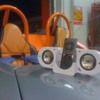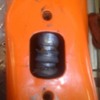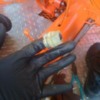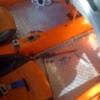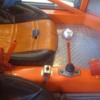The new bushing didn't go in with the Merklin Method. I have the fingers of a surgeon, and was able to fish the bushing in with my fingers and still do the pliers-scoot on the rod to pop it right into the bushing itself. I used the pliers in the opposite of their normal function to prise the wire ring open, then butt-connected the wire against itself. It made a big oval, instead of being an overlapping circle. After the bushing was in its hole, I put the retainer clip around the rod itself, hanging loosely, and worked it back into the position it needed to be in. I used a dental pick to pop the ends off of each other, and it resumed its usual shape and function.
With the circlip holding the bushing around the rod, I did the reverse-pliers scoot of the rod, until it was close to the coupler. I cut the Zip-Tie off of the rod, scooted it back another two inches as I greased the affected area, then got a little help for that last quarter-inch.
I went back to the coupler, and my buddy waited until I had my hand on the assembly to give it that last little tap. I continued adding time to the project by dropping the coupler's guts into the hole, and had a helluva time fishing them back out -- again with the hanger. I finally decided to cleverly bend the hanger like a hairpin to put pressure against the inside of the coupler bolt's sleeve half; I bent it so that it was shaped like a longbow; pressure on each end (smae side) and the middle (opposite side, or the arch of the "bow.")
I bent the hanger again, like a fishing hook, so I could worm it into the coupler's opening in the tunnel, still retain the tube, and guide into the hole in the nylon caps that the tube lives in.
I wish I had taken a picture.
The bolt went in easily, maneuvering it carefully with pliers and postal tweezers. Again with the Vise Grips and the 8mm wrench, and THAT nightmare ended.


